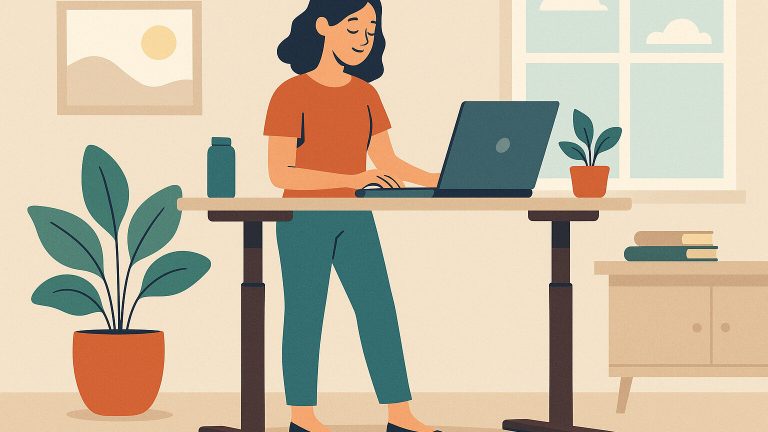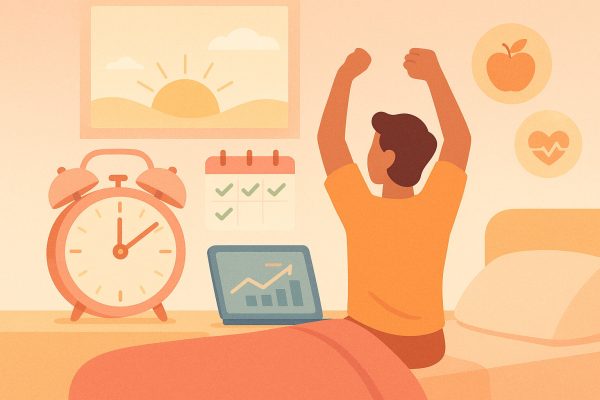Why making the switch can improve how your body feels every day
Many people spend most of their day sitting, especially during work hours. While sitting seems harmless, doing it for too long each day can affect the body in ways that aren’t always obvious at first. From tight hips to afternoon fatigue, these signs often appear slowly. That’s where standing desks come in—not as a trend, but as a tool that helps people move more and feel better throughout the day.
Standing desks aren’t about standing all day. They’re about having the choice to move between sitting and standing. This small change in routine can reduce stiffness, improve focus, and support better posture. The shift doesn’t need to be dramatic—standing just a little more each hour can already create noticeable differences in how the body feels and functions.
Many workers, from office teams to freelancers, are starting to include standing desks in their routines. Whether using a full-height adjustable desk or a simple riser, people find that standing more often helps break up long periods of sitting. It’s a habit that fits into daily life without needing a complete workspace overhaul.
Boosting energy and breaking up sluggish afternoons
The afternoon slump is familiar to many. It’s that time of day when focus slips and energy dips. A standing desk offers a quiet way to reset without caffeine or a long break. Standing encourages better blood flow and keeps the body more alert, helping to fight that heavy, slow feeling that can hit after lunch.
When the body stays in one position too long—especially sitting—circulation slows. Muscles become inactive, and the brain receives less oxygen-rich blood. Standing shifts this pattern. It reactivates muscles in the legs and back and gently raises heart rate, which can lead to a more alert state of mind.
Some workers use standing desks in short bursts during the afternoon. They might stand during a phone call or while reading emails. Even these small blocks of time can sharpen concentration and prevent the mental fog that often arrives late in the day.
Supporting better posture and easing lower back stress
Long hours at a desk often lead to slumping. Shoulders curve forward, necks crane toward screens, and hips stay locked. Over time, this posture puts pressure on the spine and tightens muscles. Standing desks help shift that alignment by encouraging more natural positioning.
When standing, the spine tends to stack more evenly. Core muscles stay active to support balance, and shoulders stay more relaxed. This doesn’t mean pain disappears overnight, but it can reduce stress on key areas and help retrain the body toward healthier habits.
For people with lower back discomfort, this change can bring relief. Alternating between sitting and standing helps avoid staying in one position too long. It encourages more movement and less strain on one part of the body. This balance supports both comfort and productivity throughout the workday.
Encouraging more movement throughout the day
Movement is part of what keeps the body feeling good. Yet many work routines include hours of stillness. With a standing desk, motion becomes easier and more natural. People often find themselves shifting weight, stretching, or stepping away from the desk more often when standing.
These little movements don’t require a gym or a workout mat. They happen naturally as the body responds to standing. Walking to fill a water bottle or pacing during a phone call becomes more likely when already upright. This gentle activity adds up and helps the body avoid stiffness.
Some users even set timers to switch positions or take brief movement breaks. These habits build rhythm into the day. They can improve how joints feel, help the mind reset, and break the cycle of all-day sitting. In this way, standing desks help spark more mindful movement during long work hours.
Improving circulation and reducing muscle fatigue
Poor circulation is often a silent issue for people who sit too long. Legs might feel heavy, feet swell, or energy dips unexpectedly. These signs are linked to blood not flowing as smoothly as it should. Standing desks can help by shifting body position and allowing gravity to support better flow.
Standing lets the legs move and stretch more easily. Blood flows more freely, helping muscles receive the oxygen and nutrients they need. This can make a big difference in how tired or energized a person feels at the end of the day.
Of course, standing too long without breaks can also cause discomfort. That’s why a balance between sitting and standing works best. The key is to stay in motion, whether through light stretching or short walks. These small steps, when added to a standing routine, help keep the body more refreshed.
Helping with focus and clearer thinking during long work tasks
Mental clarity doesn’t just come from coffee or quiet spaces. Physical movement plays a big role too. When using a standing desk, the body becomes more active, and that motion supports better brain function. Even subtle shifts in position can help a person stay focused longer.
Standing encourages better posture, which opens up the chest and supports easier breathing. With more oxygen in the system, the brain works more efficiently. Many users say that they feel more alert, less distracted, and more engaged with their tasks while standing.
People who work on complex tasks or creative projects often notice a mental lift when they stand. It becomes easier to get into a rhythm, solve problems, or stay with a thought. These mental boosts aren’t dramatic, but they make daily work more satisfying and less draining.
Creating a more flexible work environment
Modern workspaces come in many shapes and sizes—from home offices to shared coworking spaces. Standing desks add flexibility to these spaces. They support different working styles and allow for more movement without changing everything around.
Some people use full-height desks that move with the push of a button. Others use risers that sit on top of a traditional desk. Both options provide the same basic benefit: the ability to change position without leaving the workspace. This flexibility supports longer days and helps reduce fatigue.
Teams that share desks or work in open environments often find standing desks useful. They allow people to adjust their stations to their comfort level. This can support better collaboration, comfort, and morale in shared settings. Over time, it also builds a culture that values health and flexibility.
Supporting wellness goals beyond the office
For many, daily wellness includes more than just work habits. It includes sleep, diet, mood, and activity levels. Standing desks can support these larger goals by encouraging movement and improving how the body feels throughout the day.
Regular use of a standing desk often inspires other wellness choices. Someone who feels more energized at work might be more likely to cook at home, take an evening walk, or sleep more deeply. These changes grow from small shifts in daily habits that support the body’s natural needs.
The connection between standing more and feeling better isn’t just about posture or productivity. It’s about building a routine that respects the body’s need to move and rest in balance. That kind of routine supports more than just work—it supports life as a whole.
Balancing screen time with mindful physical habits
Spending long hours in front of screens is common today, whether for work, study, or leisure. That much screen time can lead to eye strain, tight neck muscles, and mental fatigue. Standing desks don’t solve those issues directly, but they do offer a way to break the pattern.
When standing, people tend to move more and take more breaks from screens. They’re more likely to step back, stretch, or glance away to rest their eyes. These simple actions help protect vision and reduce the physical stress that comes from fixed focus and still posture.
Using a standing desk can also lead to a more balanced approach to work. It reminds people to pay attention to how they feel, not just what’s on the screen. That kind of attention supports not just wellness but long-term satisfaction in how days are spent.
Why consistent use brings real benefits over time
Standing desks offer the most support when used consistently. That doesn’t mean standing all day, every day. It means finding a rhythm that includes both sitting and standing—and sticking to it most days. This routine helps the body adjust and supports long-term wellness.
Starting slowly often works best. Many users begin with 20 minutes of standing each hour, then adjust based on comfort and tasks. This approach allows the body to build strength and stamina gradually, reducing strain and encouraging success.
Over time, the positive changes add up. Posture improves, focus sharpens, and the body feels less stiff at the end of the day. These results don’t come from one big change, but from steady effort. That’s the real power of a standing desk: it supports better habits in daily life.




